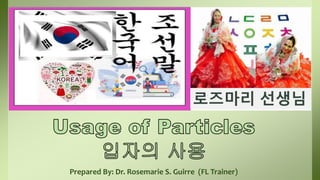
Usage of Particles 입자의 사용
- 1. Prepared By: Dr. Rosemarie S. Guirre (FL Trainer) 로즈마리 선생님
- 2. Prepared By: Dr. Rosemarie S. Guirre (FL Trainer) 9. 부터 (Start) 10. 까지 ( Until) 11. 들 (Plural) 12. 만 (Only) RECAPITULATION
- 3. OBJECTIVES Prepared By: Dr. Rosemarie S. Guirre (FL Trainer) 13. 의 ( Possessive) 14. 과/와 (and/with/as with) 15. 이랑/랑 (and/with/as with) 16. 하고 (and/with/as with) 17. 고 ( connective)
- 4. Prepared By: Dr. Rosemarie S. Guirre (FL Trainer) 선생님 차 사람 아버지 아들 딸 어머니 수건 치약 칫솔 베개 방
- 5. Prepared By: Dr. Rosemarie S. Guirre (FL Trainer) 나 아침식사 빵 커피 오늘 남자친구 쌀 초콜릿 케이크 계란 / 달걀 좋아하 여동생 남동생 싫어하
- 6. Prepared By: Dr. Rosemarie S. Guirre (FL Trainer) 나 아침식사 빵 커피 오늘 남자친구 쌀 초콜릿 케이크 계란 / 달걀 좋아하 여동생 남동생 싫어하
- 7. Prepared By: Dr. Rosemarie S. Guirre (FL Trainer) 나 아침식사 빵 커피 오늘 남자친구 쌀 초콜릿 케이크 계란 / 달걀 좋아하 여동생 남동생 싫어하
- 8. Prepared By: Dr. Rosemarie S. Guirre (FL Trainer) 나 차 공부하 저 친구 만나 오다 가 다 우리 사촌 언니/누나 마시다
- 9. Prepared By: Dr. Rosemarie S. Guirre (FL Trainer)
- 10. Prepared By: Dr. Rosemarie S. Guirre (FL Trainer)
Notes de l'éditeur
- 오늘은 sang 모음을 공부할 거에요 oneul-eun ja-eum-eul gongbuhal geoeyo jagi sogae Self intro
- Fairly straightforward, the ~의 (~ ui) particle indicates possession. It is attached to the person who possesses the object, similarly to ‘s in English. Example Sentences Using ~의 (~ ui): 선생님의 차 → the teacher’s car (object-eul,reul) (seonsaengnime cha) 그 사람의 여자친구 → that person’s girlfriend (geu sarame yeojachingu)
- You use these particles to indicate “and” or “with”. ~과 (~ gwa) is used after a consonant and ~와 (~ wa) is used after a vowel. Example Sentences Using ~과/와 (~gwa/wa): 아침식사로 빵과 커피를 먹었어요 (achimshiksaro ppanggwa kheophireul meogeosseoyo) → I ate bread and coffee for breakfast 오늘 남자친구와 영화를 보러 가요 ( oneul namjachinguwa yeonghwareul boreo gayo) → Today I will go see a movie with my boyfriend
- 이랑/랑 (~irang/rang | and/with/as with) This particle is nearly identical in use with ~과/와 (~gwa/wa). You should attach ~이랑 (irang) with a syllable ending in a consonant and ~랑 (rang) with one ending in a vowel. The main difference between these and ~과/와 (~gwa/wa) is that ~이랑/랑 (~irang/rang) is more casual to use and is also more common to hear spoken than to see in text.
- 하고 (hago | and/with/as with) ~하고 (hago) is another particle meaning “and” and “with”. It can be used with both vowels and consonants.
- 고 (~ go | connective) The ~고 (~ go) particle is used to connect two actions, happening one after another, into one sentence, attached either to an action verb or a descriptive verb. Drink=마시기 저는 자고 한국어를 공부했어요 = I slept then studied Korean 저는 친구를 만나고 나서 은행에 갈 거예요 = I will meet a friend and then go to the bank Example Sentences Using ~고 (~ go): 샤워하고 잠을 잘거에요 (shawohago jameul jalgeoeyo) → I will take a shower and then go sleep You can also use this particle to connect two adjectives describing the same topic or two sentences describing a similar topic into one sentence. For example: 그 사람이 똑똑하고 부지런한 학생이에요 (geu sarami ttokttokhago bujireonhan haksaengieyo) → That person is a smart and diligent student And yes, you can also use the ~고 particle together with the past tense.
- This particle indicates both time and location. For location, it can express where you are or were at, or where you are going, or where something is. And for time, it can express the time or day something happens.
